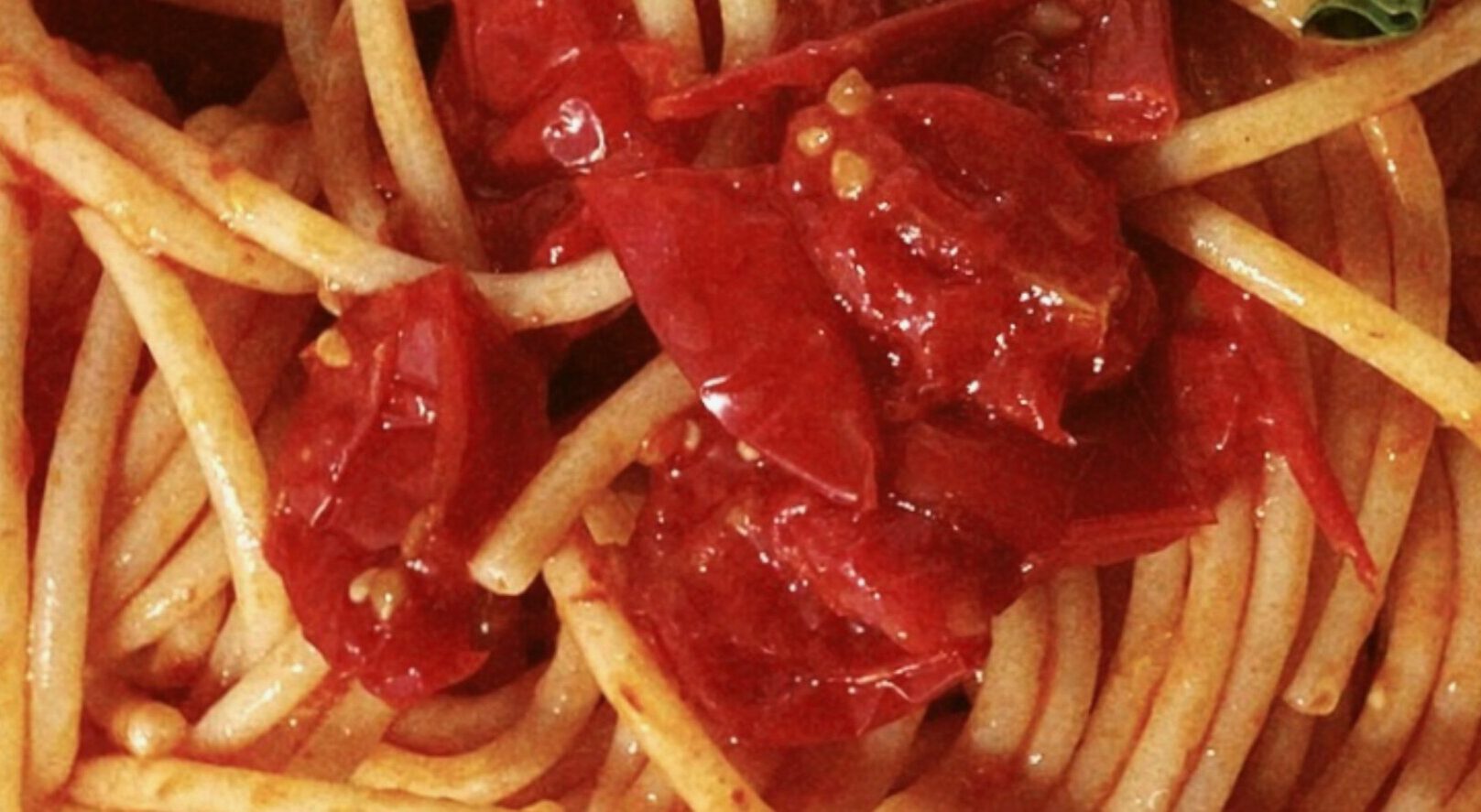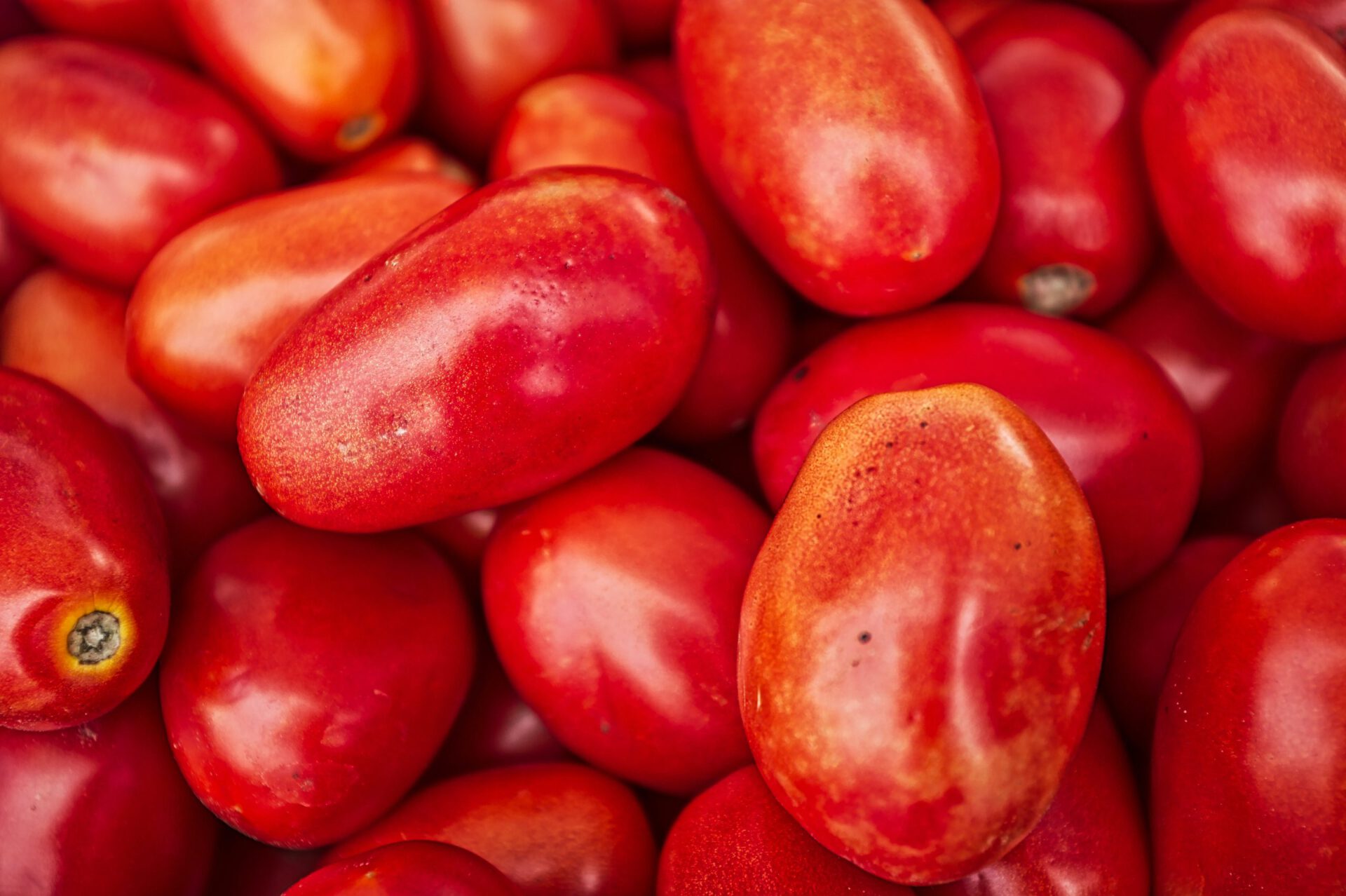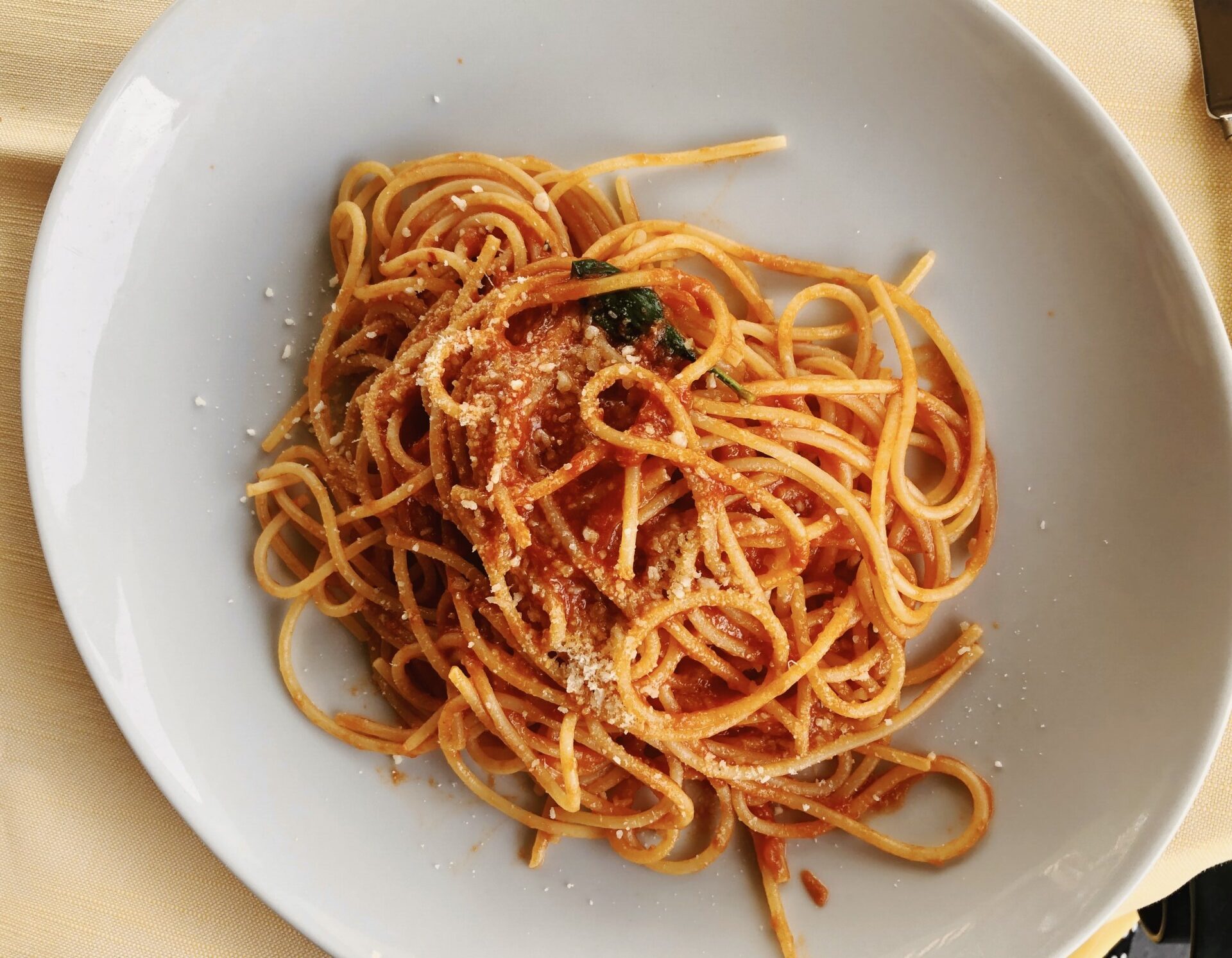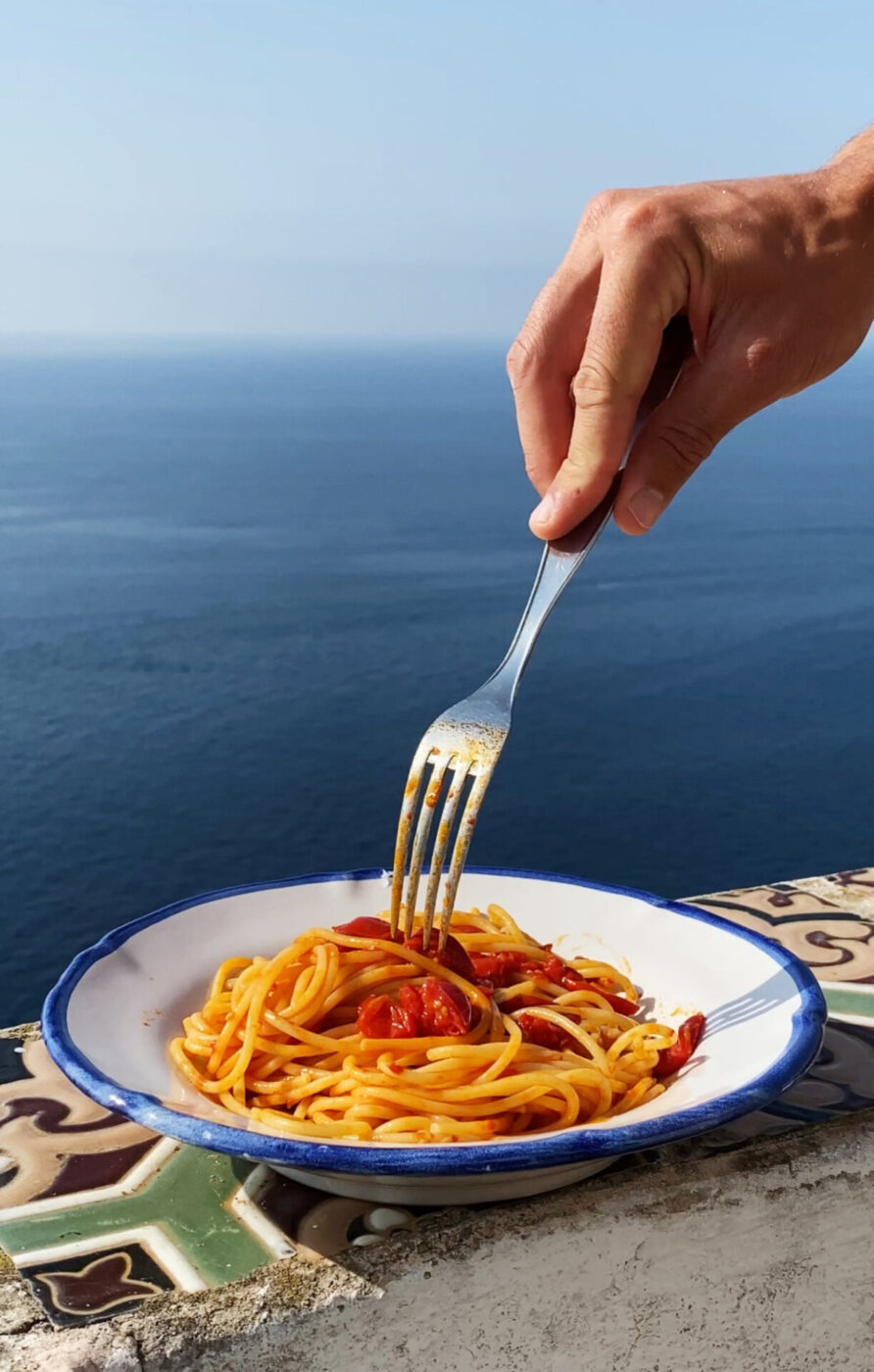We at Italy Segreta do not eat as much pasta as we did when we were kids. When we were younger, every meal had a first and second course, and pasta always managed to find its rightful spot. Now, we probably have pasta twice a week; nevertheless, when someone asks us–“What is a plate you never get tired of?”–pasta al pomodoro will always come to mind. It’s a plate you can never refuse or resist. It’s a plate with a million variations and whose perfection relies on a few but essential details.
The first official recipe for “vermicelli co le pommadore”–Neapolitan dialect for spaghetti with tomatoes–dates back to 1837, when Ippolito Cavalcanti published his cooking manual Cucina Teorico Pratica. The first edition, which contained many of his original recipes, found great success all over the Italian peninsula, leading him to print over nine editions. Here’s how he described his recipe for pasta al pomodoro in the time’s dialect:
“Vermicielli co le pommadore. Quann’è lo tiempo, pigliarraje tre rotola de pommadore, le farraje cocere, e le passaraje; po piglia no terzo de nzogna, o doje mesurelle d’uoglio, lo faraje zoffriere co na capo d’aglio, e lo miette dint’a chella sauza. Doppo scauda doje rotola di vermicielli, e vierdi vierdi li levarraje, e nce li buote pe dinto: falle chini di pepe, miettence lo sale, e poi vide che magne.”
“Spaghetti with tomatoes. When it’s the season, take 2.7kg (6 pounds) of tomatoes, cook them and then pureè; take 100 grams of lard or 200 ml of oil, pan fry a garlic bulb in the fat and add it to the tomato sauce. Boil 1.8kg (4 pounds) of spaghetti, remove from the water when still a bit undercooked, and toss with the sauce; add pepper, add salt and you will see what you will be eating.”
The recipe hides a few essential details in its simplicity, and every time we read it in its original dialect, we discover a new treasure: for example, the way Cavalcanti describes the undercooked spaghetti, al dente in today’s Italian, is “e vierdi vierdi li levarraje.” Quite literally, this phrase translates to “and still green, take them out,” making an analogy between pasta and unripe fruit. Plus, all of Cavalcanti’s recipes are portioned for twelve people! Can you blame him?! How better to appreciate a nice pot of spaghetti al pomodoro than by sharing it with a big family or group of friends?
One crucial decision that must be made is which tomatoes to use. Choices differ depending on where you live. In Italy, tomatoes are at their best in the summer–in the northern hemisphere, between May and September.
Tomatoes should be ripe, full, and crisp, and you should be able to smell a tasty one. Tomatoes that are commonly used for sauce should be completely red when ripe. Another sign of perfect readiness is what we call the “freshness crunch”: even when duly ripe and red, tomatoes should feel relatively hard and full, never soft or squishy (an indication of over ripeness or that they have been hit during transport)! Our go-to varieties of tomatoes that yield great results are cherry tomatoes (pachino), piccadilly tomatoes, or date tomatoes (datterini).
While we were trying to write, we couldn’t help ourselves and started cooking; forgive the red stains and the smell of aglio! Here’s our recipe for pasta al pomodoro. We hope it will give you all the joy it gives us every time we make this simple but eternally satisfying dish.

ITALY SEGRETA’S PASTA AL POMODORO
Serves 4
Preparation Time: 30 minutes | Cooking Time: 1 hour
Eating Time: Whatever it takes!
INGREDIENTS
- 750 gr. (27 oz.) of tomatoes
- 3 garlic cloves
- 2 Tbsp. Extra Virgin Olive Oil
- 500 gr. (17 oz.) of pasta
- Salt, to taste, plus 1 Tbsp
- Pepper, to taste (Optional)
- Fresh basil (Optional)
- Grated Parmesan cheese (Optional)
- Red pepper flakes (Optional)

PREPARATION
This recipe can work with almost any shape of pasta. Our personal favorites are spaghetti and penne, two undeniable classics.
If you want skinless sauce, follow Step 1. Otherwise, start with Step 2. We usually leave the peel on the tomatoes; however, some people might have trouble digesting it or might simply dislike the texture.
- The best and fastest way to peel tomatoes is by blanching them in a pot of boiling water for 1 to 2 minutes, not longer. You will notice after just 30 seconds that the tomatoes will bloat, and the peel will start ripping open. After 2 minutes, pull them out of the water and let them cool for a few seconds or plunge them in an ice bath; then you will be able to easily peel them with your hands.
- Cut the tomatoes into quarters and set aside.
- Cut the tips off of the garlic cloves, lightly crush them under your palm, and peel them. (This simple action will make the cloves easier to peel. Also, crushing the garlic cloves will better release their flavor when cooking.) Drizzle around 2 tablespoons of olive oil in a pot. Add the garlic and let it heat up and flavor the oil for 2 to 3 minutes.
- Add the tomatoes to the pot along with a generous sprinkle of salt. Stir on medium heat for 2 minutes so that everything is mixed. Put the heat on low and cover. Let the tomatoes cook for 40 minutes, stirring every 15 minutes or so to ensure the sauce is not drying up too much. After the first 20 minutes, we suggest fishing 2 of the garlic cloves out, leaving only one, to avoid too strong of a taste.
- While the sauce is cooking, put the water for the pasta on to boil. When it does, add one tablespoon of salt and add in the pasta. Stir occasionally so the pasta doesn’t stick. We usually cook it for no longer than two-thirds of the time recommended on the box for al dente pasta. However, taste the pasta so you can choose what you prefer.
- When the pasta is al dente, transfer it directly to the pot of sauce, and reserve one cup full of the starchy pasta water before throwing it out! You can use this water to finish cooking the pasta if the sauce gets too dry or if the pasta is too undercooked.
- Cook the pasta with the sauce on medium heat for 3 to 4 minutes, adding a little of the reserved pasta water if needed. If you’d like, add pepper to taste. Keep turning the pasta so that it absorbs all the sauce as it cooks. Add basil, grated parmesan cheese, or red pepper flakes if you’d like. When the sauce reaches a creamy consistency, remove from heat and eat!

Our Tips:
Although saucepans are typically used to cook the tomatoes, we prefer using a small pot which isn’t too wide and has higher sides, as you will need to cook the tomatoes for a long time and you don’t want them to dry up. After 40 minutes of cooking, the tomatoes should have broken down completely, and the sauce should be still very liquidy without the addition of any water.
You can also make the sauce and store it in a glass jar for later use. Closing the jar when the sauce is still very hot will help create a sous-vide, sterilized environment. If done correctly, once the jar cools down, the cap will be securely sealed (it will seem almost sucked in). You can store the sauce in the fridge or freezer for up to a year.




